Pacific Rim, Week 7: Thai 1
My classmates and I agreed that the food looked uncomfortably too much like the Chinese food we'd been cooking the previous 5 weeks, but we were all relieved to discover just how distinctly different Thai food tasted--spicy, hot, fresh, light, citrusy, and deep with intense flavors.
Here's a fuzzy photo of my plate, clockwise from the Thai Chicken Stir-fry Wrapped in Lettuce Cup: sticky rice, Chicken Satay with Peanut Sauce from Malee's on Main, Thai BBQ pork, Paht Si-Yu, Thai Coconut Ginger Rice, with On Choy and Sweet Thai Chili Pork in the middle.
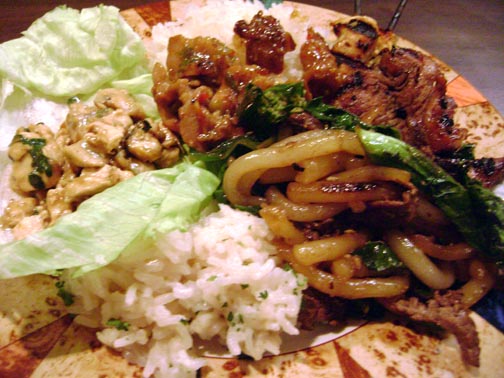
Thai BBQ Pork

Sweet Thai Chili Pork
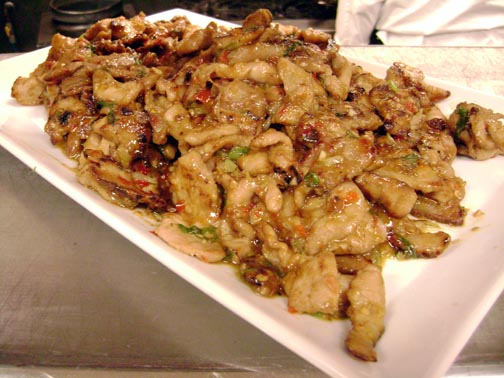
Thai Chicken Stir-fry Wrapped in Lettuce Cups. This was so good, and all just a basic stir-fry eaten in lettuce. Chef loved these when P.F. Chang's first introduced them (back when P.F. Chang's wasn't yet a chain).
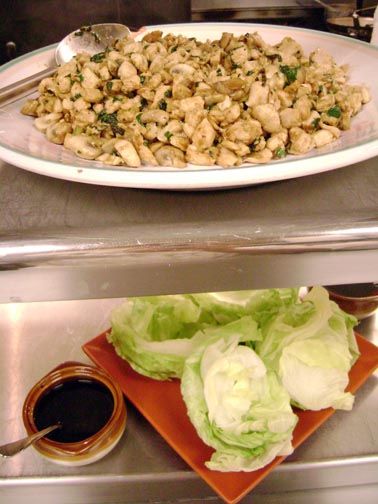
Chicken Satay. According to Chef, on a commercial kitchen's grill, there's no way the skewers won't burn. The grill really did get hot, and we had to move things along quickly to avoid overcooking and drying out the meat.

On Choy. Also known as ong choy, water spinach, kangong, and pak-boong. And of course, it's also called water morning glory and swamp cabbage. When it was introduced to the U.S. from Southeast Asia, it overwhelmed parts of the South and was classified a noxious weed and environmental hazard. AND it tastes great and has just about all the nutritional of spinach. Sigh.
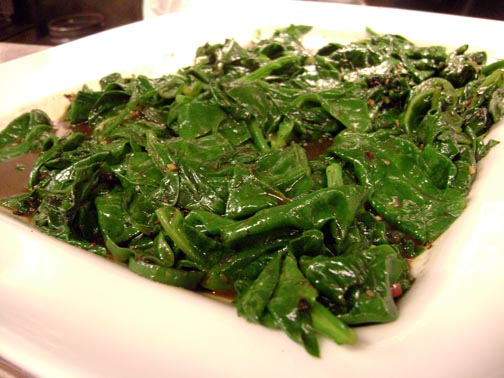
Paht Si-Yu (Rice Noodles with Soy Sauce, Water Broccoli and Beef). I've typically seen this spelled "phat si yu." Yes, as one classmate chirped, these noodles look like worms, but they taste like great! I was afraid they'd be chewy or gloppy, but the the fresh wide rice noodles were easy to eat and took on the flavor of the sauce very easily.
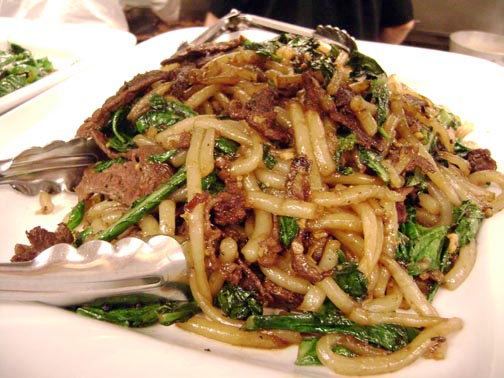
Thai Coconut Ginger Rice. It's quite close to the sticky rice you'd see served with mango and some coconut cream as a dessert, but this was cooked with savory herbs and spices.
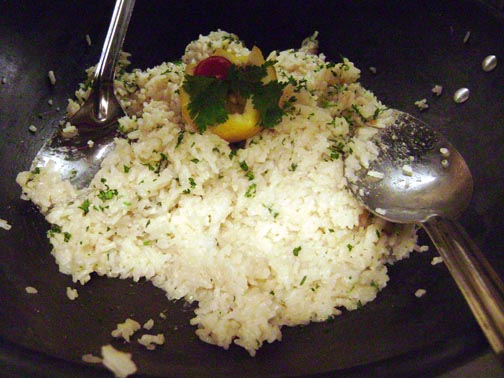
Sticky rice cooked in a special old-fashioned Thai sticky rice steaming pot. It was definitely sticky. According to Chef, the bamboo basket used in this rice cooker also doubled as a hat, and people would cook their rice in their hats. I don't quite believe it, even if I am sorta gullible sometimes.
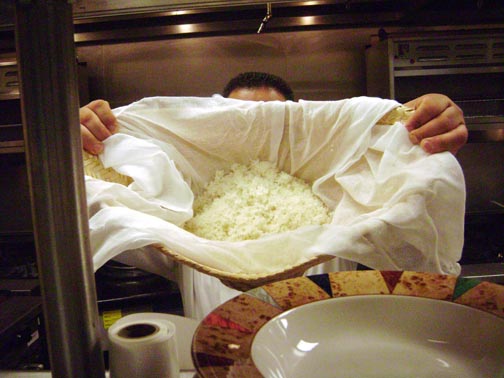
Tom Kha Gai (Thai Chicken Coconut Soup). This showcased the complex flavors I think of when I imagine Thai food--citrus overtones, galangal undertones, sweet coconut tempered by heat from the chilis--this dish made me happy. And I'm glad I didn't kill anyone while setting the hot pot up!
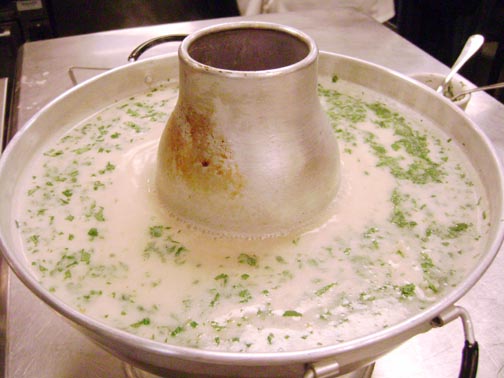
Although Chef is wary about a lot of traditional Asian desserts (tapioca, beans, jelly-type substance, etc.), he does introduce some decent fusion desserts. Tonight, we had fried ice cream with a ginger caramel sauce. I fried dessert after dinner while one of my classmates plated them with caramel. Chef wants to refine the recipe a bit, but everyone went away in love with the taste. I wish I had some right now!
Notes:
Chef isn't a fan of all the inedible ingredients in the Tom Kha Gai soup, so he had us infuse a portion of the liquid with the lemon grass, Kaffir leaves, and galangal, reducing the liquid, then combining it with the rest of the ingredients.
Chef warned us that the sticky rice we used in both dishes was "dangerous," and he warned us not too eat too much so we wouldn't risk its crazy expansion rate in our stomachs. Rad.
When making lettuce cups, Chef emphasized the importance of over-saucing the stir-fry so the lettuce cups wouldn't be drippy. The stir-fry was sauced lightly, and the rest of the sauce was reserved as dipping sauce.
Here's a fuzzy photo of my plate, clockwise from the Thai Chicken Stir-fry Wrapped in Lettuce Cup: sticky rice, Chicken Satay with Peanut Sauce from Malee's on Main, Thai BBQ pork, Paht Si-Yu, Thai Coconut Ginger Rice, with On Choy and Sweet Thai Chili Pork in the middle.

Thai BBQ Pork

Sweet Thai Chili Pork

Thai Chicken Stir-fry Wrapped in Lettuce Cups. This was so good, and all just a basic stir-fry eaten in lettuce. Chef loved these when P.F. Chang's first introduced them (back when P.F. Chang's wasn't yet a chain).

Chicken Satay. According to Chef, on a commercial kitchen's grill, there's no way the skewers won't burn. The grill really did get hot, and we had to move things along quickly to avoid overcooking and drying out the meat.

On Choy. Also known as ong choy, water spinach, kangong, and pak-boong. And of course, it's also called water morning glory and swamp cabbage. When it was introduced to the U.S. from Southeast Asia, it overwhelmed parts of the South and was classified a noxious weed and environmental hazard. AND it tastes great and has just about all the nutritional of spinach. Sigh.

Paht Si-Yu (Rice Noodles with Soy Sauce, Water Broccoli and Beef). I've typically seen this spelled "phat si yu." Yes, as one classmate chirped, these noodles look like worms, but they taste like great! I was afraid they'd be chewy or gloppy, but the the fresh wide rice noodles were easy to eat and took on the flavor of the sauce very easily.

Thai Coconut Ginger Rice. It's quite close to the sticky rice you'd see served with mango and some coconut cream as a dessert, but this was cooked with savory herbs and spices.

Sticky rice cooked in a special old-fashioned Thai sticky rice steaming pot. It was definitely sticky. According to Chef, the bamboo basket used in this rice cooker also doubled as a hat, and people would cook their rice in their hats. I don't quite believe it, even if I am sorta gullible sometimes.

Tom Kha Gai (Thai Chicken Coconut Soup). This showcased the complex flavors I think of when I imagine Thai food--citrus overtones, galangal undertones, sweet coconut tempered by heat from the chilis--this dish made me happy. And I'm glad I didn't kill anyone while setting the hot pot up!

Although Chef is wary about a lot of traditional Asian desserts (tapioca, beans, jelly-type substance, etc.), he does introduce some decent fusion desserts. Tonight, we had fried ice cream with a ginger caramel sauce. I fried dessert after dinner while one of my classmates plated them with caramel. Chef wants to refine the recipe a bit, but everyone went away in love with the taste. I wish I had some right now!
Notes:
Chef isn't a fan of all the inedible ingredients in the Tom Kha Gai soup, so he had us infuse a portion of the liquid with the lemon grass, Kaffir leaves, and galangal, reducing the liquid, then combining it with the rest of the ingredients.
Chef warned us that the sticky rice we used in both dishes was "dangerous," and he warned us not too eat too much so we wouldn't risk its crazy expansion rate in our stomachs. Rad.
When making lettuce cups, Chef emphasized the importance of over-saucing the stir-fry so the lettuce cups wouldn't be drippy. The stir-fry was sauced lightly, and the rest of the sauce was reserved as dipping sauce.
Comments
I really do prefer Thai food to Chinese, maybe having eaten too much of the latter.
Maybe you can answer a question I've had: Why do some Thai places serve dishes or soups that are still full of the flavorful but essentially inedible hunks of aromatics like lemon grass or woody slices of galangal?
I don't mean like the occasional bay leaf that might slip through in a Western sauce, but large handfuls of inedible bits that have to be picked out one by one before you can enjoy the dish (or have to be spat out because you invariably miss some).